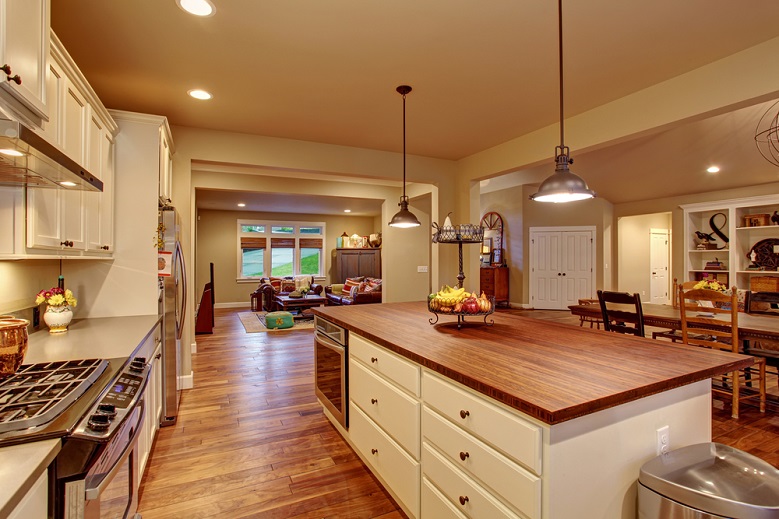
By Ethan Roberts
Home flipping is the process of purchasing an undervalued property with the intent to re-sell it quickly to make a profit.
Some investors buy homes at a big discount and re-sell them for a profit—typically less than $10,000—without making any improvements or repairs. That’s called “wholesaling.” These investors often re-sell the homes to other investors who want to use them for rentals.
But most investors flip homes by making repairs and improvements that increase the home’s value before re-selling it for a much larger profit. This is called “retailing,” and that’s what I’ll focus on today.
I like to think of the home flipping process as having three phases or steps. Each step has tasks that must be carried out for the process to run smoothly.
Phase One: Get Ready
The first thing you need to decide is how you’ll pay for the homes you’ll buy. The best way to maximize profits is to pay 100% cash, but many people don’t have that luxury. Not to worry, you have a few alternatives. A home equity line of credit (HELOC) on your primary residence is one possibility. The interest rates, which are determined in part by the prime rate, are usually low. In addition, there are no closing costs on most HELOCs.
But if you don’t have enough equity in your primary residence, the next best alternative is to take a conventional loan with 20% down. The interest rate will be similar to the HELOC, but you will have to pay about 3% of the sales price in closing costs.
After that, the next alternative is less desirable. If you don’t have the down payment or good enough credit for a conventional loan, then the usual way to finance home flipping is with a hard money loan.
Hard money is a short-term loan that’s based upon the after-repair value (ARV) of the property. The typical hard-money loan supplies the investor with 65–70% of the ARV. But these loans are very expensive. The usual fee is three points (3% of the loan amount), which you pay at closing, and the annual interest rate is typically 12%–15%. There’s often a time limit on these loans as well of six months to one year. After that, a balloon payment will be due.
Another step you need to take in this first phase is to put together a network of professionals who can assist you with your investment. Your network should include a real estate agent or Realtor, title company or real estate attorney, bank or hard-money lender, handyman/painter, and licensed contractors to do any electrical, plumbing, or roofing work that requires a permit.
Having a list of these providers in place prior to making a bid on a property is essential, because once you buy it, you’ll want to get it remodeled and back on the market as quickly as possible.
The next part of this phase would be to meet with your agent and discuss the location, area, and types of properties that you will want to target. Even if you plan on acquiring properties without an agent’s help, you will probably still need a good agent or Realtor to help you sell them quickly and for top dollar.
Phase Two: Get Set
In this phase, you’ll actually begin to scout properties, estimate your profit potential, make offers, and once an offer is accepted, buy your materials.
Scouting properties involves a good deal of time and effort, because it’s not every day that a potentially flip-worthy property is listed for sale. You may have to view eight to 10 properties before you find one that will really work for you as far as price, work needed, and potential re-sale value. The best approach is to decide in advance how much profit you realistically want to make on each home flip, and then find properties that fall within your parameters.
Always look for homes that are the “ugly ducklings” in a good neighborhood. Try to buy homes that you can sell in a price range that will attract the largest income demographic in a particular area. If you price the home too high, only a handful of buyers will have the income to qualify for it. If you price it too low, the buyers who could qualify may not have good credit or enough money for a down payment.
To estimate the profit potential of a property, it’s imperative that you accurately determine the total costs of repairs and improvements. Unless you’re a contractor, you’ll likely need to spend some time browsing the aisles of the home improvement stores to learn what materials cost. Underestimating repair costs at the start will ultimately hurt your bottom line, but overestimating costs will either cause you to pass on good opportunities or to make low-ball offers that are rarely accepted.
In addition to repairs, you also need to estimate carrying costs, such as homeowner taxes, vacant property insurance, utilities, and yard maintenance. Your Realtor can probably help you to determine those costs.
Once you secure a contract for your first purchase, it’s time to buy your materials. Don’t waste time and money by waiting until after you close to buy materials; however, only buy materials in advance that can be returned in case the transaction never closes.
During the three or four weeks prior to closing, I scour the aisles of all the big box stores in a 15-mile radius, looking for quality items that are on sale. I’ve bought appliances and cabinets that were 20% off, simply by timing my purchases to when they go on sale.
Other materials I can often pick up at discounted prices are ceiling fans, light fixtures, and paint. In addition, I use store credit cards that offer a 5% discount on all purchases, even those already on sale. You can save hundreds of dollars on materials this way, and improve your profit margin on each flip.
Phase Three: Go!
This phase involves the actual project managing, rehabbing, and re-sale of the finished product. Time is money when it comes to flipping homes, and so it’s vital that you rehab quickly, do as much of the work yourself if possible, and line up your helpers and licensed contractors in advance of the closing, so you don’t have to wait on them.
As the project manager, your success in flipping a home depends on your ability to keep the rehabbing process organized and doing things in the proper sequence. For example, when planning the schedule for the flooring installation, you have to allow adequate time for the painting to be finished before you can install carpet or other flooring.
But sometimes, despite our best efforts, unexpected events throw the rehabbing off schedule. Workers get sick or get delayed on previous jobs. It rains on the days you’re planning to paint the exterior or do other work. Materials that you ordered might be delayed, so a particular job can’t be finished, which then delays other work from starting.
At times like these, it’s vital to keep your cool and always have a plan B for other work that can be done while you wait. If you can’t install floors yet, perhaps you can pressure wash the outside deck. If you can’t paint the exterior, hang up ceiling fans and fixtures.
Remember to focus most of your rehabbing dollars on kitchens and bathrooms, which are the most important rooms when it comes to selling a home. Those rooms will also give you the best appraisal returns for your rehab dollars. Make sure the exterior has good curb appeal and that the interior is finished and totally clean before you begin showing the home. The colors of the paint, fixtures, and flooring should all be neutral.
When marketing the home, try to price it just under other similar homes in the area. If possible, market the property even more attractive by offering to pay the buyer’s closing costs.
The road from start to finish is a long one, but if you follow these guidelines, your first home flipping project is sure to be a winner. Good luck!

Ethan Roberts is a real estate writer, editor and investor. He’s a frequent contributor to InvestorPlace, and his work has been featured on MSN Money and Reuters. He’s also written for Seeking Alpha, Investopedia, The Fiscal Times, ForSaleByOwner and Smarty Cents, and was one of five contributing editors to The Tycoon Report. He’s been investing in real estate since 1995 and has been a Realtor since 1998. He also teaches classes on investing in residential real estate.

